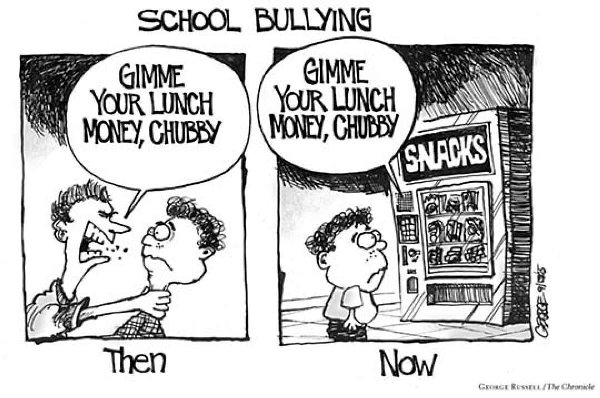
 Found a word you're not familiar with? Double-click that word to bring up a dictionary reference to it. The dictionary page includes an audio sound file with which to actually hear the word said. Found a word you're not familiar with? Double-click that word to bring up a dictionary reference to it. The dictionary page includes an audio sound file with which to actually hear the word said. |
 Further implications
Further implications
Concern regarding the diet and health of Australian children has sparked debate on the way schools should respond. Regulating school lunches does not seem a sufficient response. If social media is an accurate gauge, teachers monitoring student lunchboxes appears to provoke hostility among parents and so may not be an effective tool for educating either children or their families about good eating habits. It also does little to address social inequality, where children may be poorly feed or sometimes not feed at all because of family poverty.
One proposal which seems to be building a slow momentum is that schools should supply meals to students. Currently, many schools across Australia have set up free breakfast clubs, or offer emergency food and lunches. These measures are targeted at children who might otherwise go hungry. However, these programs are not consistent across Australia, with some funded by schools, and others through food agencies, donations, or by state governments. The Victorian government, for instance, spent A$13.7 million on breakfast clubs from 2016 to 2019. As a result, students in around 500 of Victoria's most disadvantaged primary schools have had access to nutritious food. The Victorian government has also committed a further $58 million to expand the program to 1,000 schools in the state from 2019 to 2023, providing free lunches and holiday food supplies to many schools that had not previously been able to supply them. Other examples include the New South Wales government's commitment of $8 million in June 2019 to expand their School Breakfast 4 Health program to an additional 500 schools in New South Wales and the Australian Capital Territory. The challenges posed by COVID19, which has made the gap between the advantaged and the disadvantaged more evident, appears to have increased pressure for more formal and widespread provision of meals through schools.

The possibility of Australian schools supplying all students with lunches has attracted significant recent attention. Some of these school lunch proposals would involve parents having to pay a charge for the food supplied. A report published in January 2021 detailed the findings of a Flinders University investigation into the pros and cons of school provided lunches. It concluded that the uniform delivery of lunchtime food at school could be a solution to better childhood nutrition and learning in Australia. As outlined in the Flinders scheme, nutritious meals would be prepared on site and served to children in their classroom, school hall or school yard, compared with the current school food model in Australia where generally parents provide lunch to their children, either as a lunchbox packed from home or purchased from a school canteen. Under this proposal, parents would pay for meals, with fees subsidised according to family income. Teachers could also eat the meals, and students could have the option to be involved in the cooking. The advantage of this type of scheme would be some offset in the cost to government, though the charging of a fee might reduce the number of children who would take part.

There has also been some interest within several Australian jurisdictions in supplying free school lunches to all children. In December 2020, the results of a trial of free school lunches in three Tasmanian schools were reported. All children at these schools were invited to a hot sit-down meal every day for four weeks. Numerous improvements were noted, including an improvement in school attendance. One of the school principals stated, 'We've seen a lot more student engagement in the classrooms, a lot more attention, focus and drive with their learning... The food that's being provided isn't just a sandwich. It's food that's been nutritionally looked at so that it sustains their energy levels and their... stamina throughout their learning day,'
 Similarly, in September 2020, as part of its re-election program, the Canberra Labor government announced a plan to trial free breakfasts and lunches three days a week at five public schools in the Australian Capital Territory. The trial is aimed at determining if supplying students with better nutrition improves their engagement. It is also intended to ensure that no students are going hungry.
Similarly, in September 2020, as part of its re-election program, the Canberra Labor government announced a plan to trial free breakfasts and lunches three days a week at five public schools in the Australian Capital Territory. The trial is aimed at determining if supplying students with better nutrition improves their engagement. It is also intended to ensure that no students are going hungry.  Some schools and local areas have taken independent initiatives to supply free meals to their students. Mooroopna Park Primary School, located near Shepparton, Victoria, has relied on food donations, fundraising and the support of the Greater Shepparton Lighthouse Project to employ a full-time chef to cook breakfast. morning tea, lunch, and afternoon tea for students. The primary school is one of the most disadvantaged in the state. The school's principal has stated, 'As a school, we have no doubt it has been really positive in terms of student engagement, parent engagement and attendance, which ultimately reflects in students' outcomes.'
Some schools and local areas have taken independent initiatives to supply free meals to their students. Mooroopna Park Primary School, located near Shepparton, Victoria, has relied on food donations, fundraising and the support of the Greater Shepparton Lighthouse Project to employ a full-time chef to cook breakfast. morning tea, lunch, and afternoon tea for students. The primary school is one of the most disadvantaged in the state. The school's principal has stated, 'As a school, we have no doubt it has been really positive in terms of student engagement, parent engagement and attendance, which ultimately reflects in students' outcomes.' 
